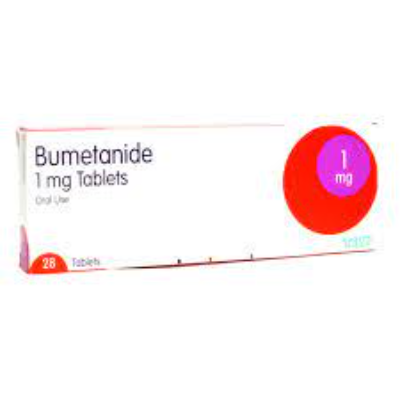


Treatment of oedema, such as that associated with:
Cardiac failure
Hepatic cirrhosis
Renal disease (including nephrotic syndrome)
1mg to be taken in the morning (or early evening). A second dose can be given 6 to 8 hours later if necessary. Increase dose until adequate diuresis is obtained.
In severe cases, (e.g. oedema of cardiac or renal origin), higher doses may be necessary, and 5mg daily may be given. This can be increased, if necessary, by 5mg every 12 to 24 hours until an adequate response is obtained or side effects appear.
Adjust dosage according to response. A daily dose of 500 micrograms may be sufficient in some elderly patients.
(See Dosage; Adult)
15 to 50 micrograms/kg given one to four times daily. Maximum dose is 2mg per dose or 5mg per day.
Use with caution.
Higher doses may be needed to induce diuresis in renal insufficiency.
Treatment should be stopped if increased blood urea, oliguria or anuria develop.
For oral administration.
Raised blood urea
Oliguria or anuria
Hepatic coma
Breast feeding ( See Lactation section )
Neonates
Hypovolaemia
Hypotension
Severe hypokalaemia
Severe hyponatraemia
Precomatose states associated with liver cirrhosis
Renal impairment due to hepatotoxic drugs
Renal impairment due to nephrotoxic drugs
Long QT syndrome
Torsade de pointes
Correct hypovolaemia and hypotension before initiation of treatment.
NSAIDs may antagonise the action of diuretics. Patients should be advised not to take NSAIDs unless advised by a clinician.
Rapid mobilisation of oedema may cause circulatory collapse, particularly in elderly patients. This should be born in mind when bumetanide is given in high doses.
Electrolyte disturbances may occur, particularly in patients with a low salt diet.
Use with caution in patients suspected of electrolyte imbalances
Regularly monitor serum electrolytes, particularly sodium, potassium, chloride and bicarbonate.
Supplemental electrolytes may be required.
Diabetes mellitus - monitor blood and urinary glucose in patients with diabetes mellitus and those suspected of latent diabetes.
Chronic renal failure patients should remain under constant hospital supervision.
Discontinue if blood urea increases or oliguria/anuria occur during treatment for oedema due to renal insufficiency.
Use in caution in patients taking nephrotoxic or ototoxic drugs.
In prostatic hypertrophy urinary retention may occur. This can be avoided by the use of low doses and less potent diuretics initially. An adequate urinary output should be established before initiating treatment.
May exacerbate gout.
May cause dizziness or fatigue, patients should not drive or operate machinery if they experience these effects.
Hepatic impairment - ( see Dosage - hepatic impairment).
Renal impairment - ( see Dosage - renal impairment).
Pregnancy - (see Pregnancy section).
Elderly (see Dosage Elderly ).
Children 1 month - 12 years (see Dosage Children ).
Can cause a positive anti doping test in athletes.
Some formulations contain lactose and should be avoided in patients with galactosaemia, glucose-galactose malabsorption syndrome and lactose intolerance.
Some formulations contain sorbitol and should be avoided in patients with hereditary fructose intolerance.
Use with caution in patients with a family history of long QT syndrome and patients with a history of torsade de pointes.
Consider monitoring ECG in patients at risk of QT prolongation.
Correct electrolyte disorders before treatment.
Diuretics are no longer part of the standard therapy for hypertension and oedema during pregnancy. They should only be used for particular indications. Bumetanide has been recommended for the treatment of nephrotic syndrome in pregnancy.
Diuretics can reduce the plasma volume and lead to a reduced perfusion of the placenta.
There is inadequate data on the use of this drug in pregnancy so it is not generally recommended.
Abdominal pain
Vomiting
Dyspepsia
Diarrhoea
Abdominal cramps
Muscle cramps
Arthralgia
Dizziness
Fatigue
Hypotension
Headache
Nausea
Encephalopathy
Fluid and electrolyte disturbances
Dehydration
Hyperuricaemia
Blood urea increased
Serum creatinine increased
Hyperglycaemia
Alterations in hepatic enzymes
Rash
Pruritus
Urticaria
Thrombocytopenia
Gynaecomastia
Breast pain
Bone marrow depression
Hearing disturbances
Tinnitus
Deafness
Musculoskeletal pain
Muscle spasm
Hyponatraemia
Hypokalaemia
Hypomagnesaemia
Hypochloraemic alkalosis
Gout
Photosensitivity
Pancreatitis
Myalgia
Circulatory collapse
Leukopenia
Agranulocytosis
Hypocalcaemia
Hyperlipidaemia
Cholestasis
Jaundice
Dermatitis
Acute renal failure
Hypersensitivity reactions
Orthostatic hypotension
Urinary retention
Visual disturbance